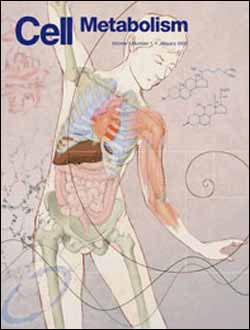Fat hormone acts on brain circuit to curb obesity, diabetes

New research published in the premier issue of Cell Metabolism finds that a single brain region is sufficient for normal control of blood sugar and activity level by the fat hormone leptin. The same region also exerts significant, though more modest, control over leptin’s effects on body weight. The findings in mice provide insight into potential mechanisms underlying type II diabetes and suggest new avenues for treatment, according to the researchers.
Secreted by fat cells, leptin signals the status of the body’s energy content to the brain and is required for normal body weight and glucose balance. Mice lacking leptin develop obesity, diabetes, and inactivity, among other symptoms.
The new results suggest that leptin signaling acts directly on the brain region known as the hypothalamic arcuate nucleus (ARH) to control insulin and glucose levels in the bloodstream, report Joel Elmquist and Bradford Lowell, both of Beth Israel Deaconess Medical Center and Harvard Medical School, and their colleagues. ARH neurons also mediate the majority, if not all, of the hormone’s action on locomotor activity, they found.
Leptin receptors in the ARH accounted for approximately 22 percent of the hormone’s effects on body weight, the group reports, suggesting that other brain regions are also important to this hormonal function.
“As the incidence of obesity and diabetes continues to rise in industrialized countries, a clear understanding of the cellular and neuroanatomic pathways that control energy and glucose balance is critical to the discovery of new methods to prevent or treat these conditions,” Elmquist said. “The current findings definitively demonstrate that the hypothalamic arcuate nucleus is required for normal body weight homeostasis and is sufficient to control leptin’s anti-diabetic actions.”
Using a novel technique, the researchers unilaterally re-activated leptin receptors in the ARH of mice in which they had otherwise blocked all leptin receptor activity. The ARH had been proposed as an important site of leptin action.
At 12 weeks of age, mice with restored receptor activity had an approximately 22 percent decline in total body weight due to a reduction in fat mass, compared to those lacking active leptin receptors, they found.
Restoration of leptin signaling also remarkably improved glucose homeostasis in the mice. Eight weeks after the treatment, blood glucose levels in the mice were indistinguishable from normal mice of the same age. The restored mice also exhibited significant increases in locomotor activity compared to leptin-deficient mice. Their activity levels were equivalent to that typical of normal mice.
While earlier studies had shown that leptin acts primarily through its effects on the central nervous system, the findings provide important new details about which brain areas mediate each of the fat hormone’s many actions, the researchers said. The results further suggest that deficits in certain regions of the central nervous system might underlie type II diabetes, Elmquist added.
Roberto Coppari, Masumi Ichinose, Charlotte E. Lee, Abigail E. Pullen, Christopher D. Kenny, Robert A. McGovern, Vinsee Tang, Shun M. Liu, Thomas Ludwig, Streamson C. Chua Jr., Bradford B. Lowell, and Joel K. Elmquist: “The hypothalamic arcuate nucleus: A key site for mediating leptin’s effects on glucose homeostasis and locomotor activity”
Media Contact
All latest news from the category: Health and Medicine
This subject area encompasses research and studies in the field of human medicine.
Among the wide-ranging list of topics covered here are anesthesiology, anatomy, surgery, human genetics, hygiene and environmental medicine, internal medicine, neurology, pharmacology, physiology, urology and dental medicine.
Newest articles

Superradiant atoms could push the boundaries of how precisely time can be measured
Superradiant atoms can help us measure time more precisely than ever. In a new study, researchers from the University of Copenhagen present a new method for measuring the time interval,…

Ion thermoelectric conversion devices for near room temperature
The electrode sheet of the thermoelectric device consists of ionic hydrogel, which is sandwiched between the electrodes to form, and the Prussian blue on the electrode undergoes a redox reaction…

Zap Energy achieves 37-million-degree temperatures in a compact device
New publication reports record electron temperatures for a small-scale, sheared-flow-stabilized Z-pinch fusion device. In the nine decades since humans first produced fusion reactions, only a few fusion technologies have demonstrated…





















